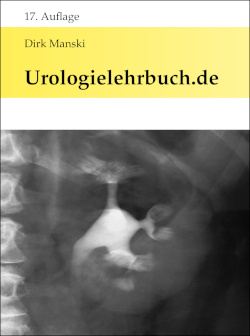Sie sind hier: Startseite > perioperative Therapie > Wunddrainagen > Penrose-Drainage
Penrose-Drainage in der Urologie
Drainageprinzip der Penrose-Drainage:
Bei der Penrose-Drainage handelt es sich um eine offene Wunddrainage, bei der der Saugeffekt durch die Kapillarwirkung der gerillten Oberfläche der Innenseite des flexiblen Silikonschlauches entsteht. Das Wundsekret wird meist direkt in den Wundverband oder in einen auf die Haut geklebten Sekretbeutel abgeleitet (offene oder halboffene Anwendung).
Urologische Indikationen:
Drainage von infektiösen Erkrankungen der äußeren Genitalien nach chirurgischer Versorgung (z.B. Skrotalabszess oder Fournier-Gangrän).
Weitere Drainagen für Urologische Operationen:
| Zurück |
Falls Sie JavaScript deaktiviert haben, benutzen Sie bitte den Zurück-Button Ihres Browsers.
Sachregistersuche: A B C D E F G H I J K L M N O P Q R S T U V W X Y Z
Literatur zur Penrosedrainage
Baier, P. K., Glück, N. C., Baumgartner, U., Adam, U., Fischer, A., and Hopt, U. T. (2010). Subcutaneous redon drains do not reduce the incidence of surgical site infections after laparotomy. a randomized controlled trial on 200 patients.Int J Colorectal Dis.
Fernandez, E. D. and Jost, S. (2003).
Abdominelle drainagen.
Chirurg, 74:91–98.
Gurusamy, K. S. and Samraj, K. (2007).
Routine abdominal drainage for uncomplicated open cholecystectomy.
Cochrane Database Syst Rev, (2):CD006003.
Locker, D., Norwood, S. H., Torma, M. J., and Fontenelle, L. J. (1983).
A prospective randomized study of drained and undrained
cholecystectomies.
Am Surg, 49(10):528-30.
Monson, J. R., Guillou, P. J., Keane, F. B., Tanner, W. A., and Brennan, T. G.
(1991).
Cholecystectomy is safer without drainage: the results of a
prospective, randomized clinical trial.
Surgery, 109(6):740-6.
Nomura, T., Shirai, Y., Okamoto, H., and Hatakeyama, K. (1998).
Bowel perforation caused by silicone drains: a report of two cases.
Surg Today, 28(9):940-942.
Sachedina, N., Santos, R. D. L., Manoharan, M., and Soloway, M. S. (2009).
Total prostatectomy and lymph node dissection may be done safely
without pelvic drainage: an extended experience of over 600 cases.
Can J Urol, 16(4):4721–4725.
Treutner, K.-H., Bertram, P., Müller, S. A., and Schumpelick, V. (2003).
[material and structure of drainages].
Chirurg, 74(2):85-90.
Urologielehrbuch.de ohne Werbung
Diese Internetseite ermöglicht mit Hilfe von Werbung den Volltext-Zugriff auf das aktuelle Urologielehrbuch.de. Viele Bilder sind zum Schutz von Laien verpixelt oder ausgeblendet. Regelmäßig wiederkehrende (fachkundige) Leser können die Werbebanner abschalten und Zugriff auf alle Abbildungen erhalten: Werden Sie Mitglied über die Crowdfunding-Plattform Steady und unterstützen Sie damit Urologielehrbuch.de.
Urologielehrbuch.de als Hardcover-Buch
 Aktuell, detailliert und übersichtlich: Urologielehrbuch.de wird auch als hochwertiges Hardcover-Buch veröffentlicht. Die 17. Auflage (Ausgabe 2024) ist seit Oktober 2024 verfügbar, siehe Abschnitt Neuigkeiten für die Aktualisierungen und Links für den Buchkauf.
Aktuell, detailliert und übersichtlich: Urologielehrbuch.de wird auch als hochwertiges Hardcover-Buch veröffentlicht. Die 17. Auflage (Ausgabe 2024) ist seit Oktober 2024 verfügbar, siehe Abschnitt Neuigkeiten für die Aktualisierungen und Links für den Buchkauf.